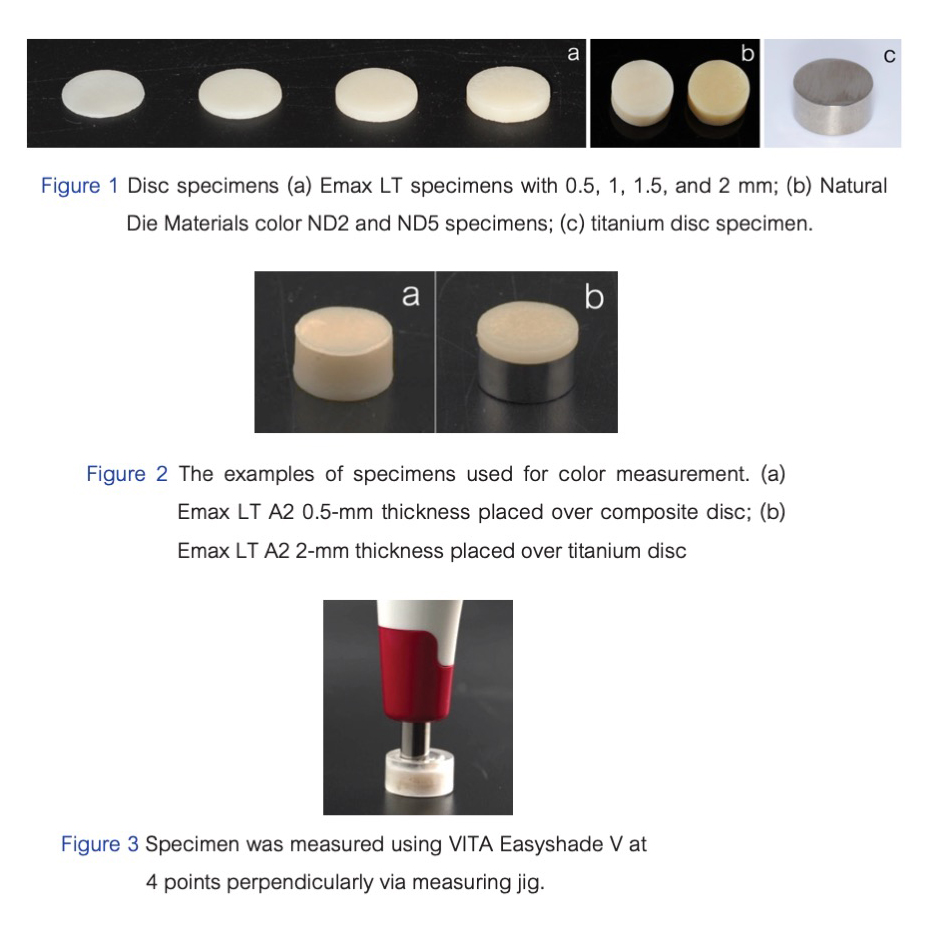Effect of lithium disilicate ceramic thickness on the color outcome of titanium implant abutment
Main Article Content
Abstract
Objective: This study aimed to compare the effects of lithium disilicate thickness on the final color outcome between ceramic restorations on titanium discs and natural die color discs.
Materials and Methods: To represent the color of crown on implant, 10-mm diameter IPS e.max (Emax) LT A2 discs with different thicknesses (1, 1.5, and 2 mm) were matched on the titanium disc. To represent the color of veneer on natural teeth (control groups), a 10-mm diameter Emax LT A2 discs with 0.5-mm thickness were placed on either ND2 (light color) or ND5 (medium-light color) natural die-colored composite discs. The specimens were measured at 4 points by the VITA Easyshade V. The data were captured by the CIELab color system. Mean values of L*, a*, and b* were calculated, and then the ΔE values were used to compare the color difference between the control and experimental groups. Data were analyzed by one-way ANOVA followed by Tukey’s post-hoc (P<0.05).
Result: The color difference (ΔE) values for Emax with a thickness of 0.5 mm on the ND2 composite disc
compared with Emax with a thickness of 1.5 mm (ΔE = 1.05 ± 0.45) and 2 mm (ΔE = 2.10 ± 0.67) on titanium discs, were found to be lower than perceptibility threshold (ΔE<2.6). When comparing Emax with a thickness
of 0.5 mm on ND5 composite discs, the Emax with a thickness of 1.5 mm (ΔE = 2.40 ± 0.35) and 2 mm
(ΔE = 1.19 ± 0.38) on titanium discs, were also found to be lower than perceptibility threshold (ΔE<2.6).
The thickness of ceramic had a significant effect on the color of restoration (P<0.05).
Conclusion: Titanium discs covered with Emax thicker than or equal to 1.5 mm could achieve color matching with 0.5-mm thickness of Emax on both ND2 and ND5 composite discs.
Article Details

This work is licensed under a Creative Commons Attribution-NonCommercial-NoDerivatives 4.0 International License.
References
Leevailoj C, Monaraks R. The longevity of ceramic veneers: clinical evaluation of mechanical, biologic and aesthetic performances of ceramic veneers, a 7-year retrospective study. J Dent Assoc Thai. 2018 Jul-Sep;68(3):288–301. doi: 10.14456/jdat.2018.35.
Fu wang, Hidekazu Takahashi, Naohiko Iwasaki. Translucency of dental ceramics with different thicknesses. J Prosthet Dent. 2013 Jul;110:14-20. doi: 10.1016/S0022-3913(13)60333-9.
Gu D, Dede Ö, Arma A, Ceylan G, Celik E, Cankaya S, et al. Influence of implant abutment material on the color of different ceramic crown system. J Prosthet Dent. 2016 Nov;116(5):764-769. doi: 10.1016/j.prosdent.2016.04.004.
Elsayed A, Wille S, Al-Akhali M, Kern M. Comparison of fracture strength and failure mode of different ceramic implant abutments. J Prosthet Dent. 2017 Apr;117(4):499-506. doi: 10.1016/j.prosdent.2016.06.018.
Stimmelmayr M, Edelhoff D, Güth JF, Erdelt K, Happe A, Beuer F. Wear at the titanium-titanium and the titanium-zirconia implant-abutment interface: A comparative in vitro study. Dent Mater. 2012 Dec;28(12):1215-20. doi: 10.1016/j.dental.2012.08.008.
Mostafavi AS, Mojtahedi H, Javanmard A. Hybrid Implant Abutments: A Literature Review. Eur J Gen Dent. 2021 Sep;10(2):106–15. doi: 10.1055/s-0041-1735766.
Beumer, John III; Faulkner, Robert F.; Shah, Kumar C.; Moy PK. Fundamentals of Implant Dentistry, Volume 1: Prosthodontic Principles. Quintessence Publishing CO,Inc. Beijing: Quintessence Publishing CO,Inc; 2015.
Jirajariyavej B, Wanapirom P, Anunmana C. Inuence of implant abutment material and ceramic thickness on optical properties. J Prosthet Dent. 2018 May;119(5):819-825. doi: 10.1016/j.prosdent.2017.05.015.
Cho YE, Lim YJ, Han JS, Yeo ISL, Yoon HI. Effect of yttria content on the translucency and masking ability of yttria-stabilized tetragonal zirconia polycrystal. Materials (Basel). 2020 Oct 22;13(21):4726. doi: 10.3390/ma13214726.
Douglas RD, Steinhauer TJ, Wee AG. Intraoral determination of the tolerance of dentists for perceptibility and acceptability of shade mismatch. J Prosthet Dent. 2007 Apr;97(4):200-8. doi: 10.1016/j.prosdent.2007.02.012.
G.Basso, A.Kodama, A.Pimentel et al. Masking Colored Substrates Using Monolithic and Bilayer CAD-CAM Ceramic Structures. Oper Dent. 2017 Jul/Aug;42(4):387-395. doi: 10.2341/16-247-L.
Dozic A, Kleverlaan J, Meegdes M, Der J Van. The influence of porcelain layer thickness on the final shade of ceramic restorations. J Prosthet Dent. 2003 Dec;90(6):563-70. doi: 10.1016/s0022-3913(03)00517-1.
Shokry TE, Shen C, Elhosary MM, Elkhodary AM. Effect of core and veneer thicknesses on the color parameters of two all-ceramic systems. J Prosthet Dent. 2006 Feb;95(2):124-9. doi: 10.1016/j.prosdent.2005.12.001.
Ozturk O, Uludag B. The effect of ceramic thickness and number of firings on the color of two all-ceramic systems. J Prosthet Dent. 2008 Aug;100(2):99-106. doi: 10.1016/S0022-3913(08)60156-0.
Ajlouni K, Elshahawy W, Ajlouni R, Sadakah A. Color masking measurement for ceramic coating of titanium used for dental implants. J Prosthet Dent. 2018 Mar;119(3):426-431. doi: 10.1016/j.prosdent.2017.04.008.
Hemmati Y. Main Factors Affecting the Final Color of Ceramic Restorations. Adv Dent Oral Heal. 2017 Jul 21;5(3). doi: 10.19080/ADOH.2017.05.555661.
Sikri VK. Color: Implications in dentistry. J Conserv Dent. 2010 Oct-Dec; 13(4): 249–255. doi: 10.4103/0972-0707.73381.


